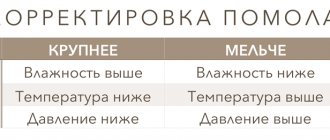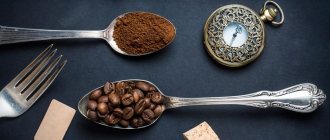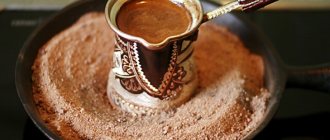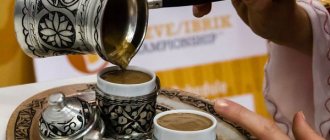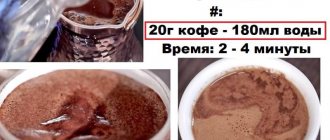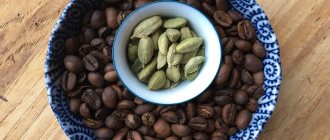The strength and taste of the drink directly depends on how many spoons of coffee are placed in the cup. But one container can be 100 ml, and another 200. Spoons also come in different sizes. Yes, and you can fill them heaped or flush with the edges. Therefore, the calculation of the volume of ground grain in cutlery is conditional. We will teach you how to navigate the world of household measurements and suggest options for different recipes and brewing methods.
About the dependence of taste on the amount of product
The amount of ground Arabica coffee in the mug affects the strength. This indicator is individual. Some people prefer bitterness due to excessive saturation. Others are diluted with water until translucent.
Expert opinion
Vadim Kudryavtsev
Coffee expert, professional barista and simply in love with this aromatic drink.
Ask the barista a question
The aroma depends 30% on the weight of the powder when brewing. The type of grain, degree of roasting and type of grinding are the remaining percentages. All components are interconnected and affect the taste of the final product.
Teaspoons and tablespoons are universal measuring instruments. At home, they are indispensable for determining the weight of products.
When calculating the amount of ground beans, it is necessary to take into account the size of the container into which the cooked finished product is poured. Its size is also individual, you can even pour it into a 0.5 liter mug.
Different weights in one volume
The same volume with different grinds weighs differently. A teaspoon will hold 13-16 coffee beans, which weigh on average 2.8 g. When ground into a coarse form with large particles, they will pull less than when finely ground. Therefore, the weight of the powder without a slide ranges from 3 to 4 g.
Interesting! About growing coffee at home
This difference must be taken into account when measuring with cutlery. The resulting error is not taken into account. It is completely covered by ease of use. Different variations of weight and filling are discussed in more detail in the article “How many grams of coffee are in a teaspoon and a tablespoon.”
The standard option for a 100 ml cup involves 1 tsp. soluble powder, which is poured flush with the edges. The weight will be 2.5 g. If the mug holds 150 ml, then take a heaped spoon.
What mugs do you most often drink coffee in?
SmallStandard
Grain consumption
Grams in spoons
Calculation of the amount of coffee mass depends on the type of cookware. You need to put one amount of ground powder into the cup in the coffee machine, and another into the cuvette.
The measure of weight varies from spoon to spoon.
A tablespoon holds up to 12 grams of coffee powder, a heaping spoon holds 20.
A heaped teaspoon holds 6-7 grams of coffee. These numbers are considered the norm for making espresso. Without a slide, the indicator drops to 4.
A small coffee spoon takes 2.5 grams of grain powder.
The topic is covered in detail in the article “How many grams of coffee are in a teaspoon and a tablespoon.”
Spoons in cups
How much coffee a barista will use depends on the size of the cup they use for their drinks.
A small demitasse cup holds 60 milliliters of liquid, to brew which you need to take 6-7 grams of coffee mass.
With a capacity of 200 milliliters, one cup contains 10 grams.
You will be interested in the article “How many spoons of coffee to put in a cup.”
Quantity and cost
Let's determine the consumption of coffee beans. In a coffee machine, for example, you can prepare different drinks. It all depends on their type and strength, as well as the variety of coffee berries.
The machine grinds 7-8 grams of coffee per serving.
It turns out that from 1 kg of coffee you can make: 1000/8 = 125 cups. If we consider that high-quality varieties of Arabica cost 600 rubles, then the price of beans for 1 serving of espresso is: 600/1000×8 = 4.8 rubles.
Espresso in a coffee shop costs from 60 rubles. From one kilogram the coffee shop will receive: 125×60=7500 rubles in revenue, with costs of 600 rubles.
Interesting! How to brew coffee with foam in a Turk at home
A drink from a coffee machine sells for 35 rubles. From a kilogram of powder you can get revenue in the amount of: 125 × 32 = 4375 rubles at a cost of 600 rubles.
A coffee machine costs on average 50,000 rubles. To recoup its purchase, the coffee shop needs to brew 7 kilograms of ground powder to sell coffee.
Norm of Beethoven's standard cup and mug
Now let’s calculate the amount of ground Arabica coffee per cup: how many spoons of coffee should be put in 100 ml of water. If you take a coarse grind, then for brewing you need to put two large heaped teaspoons. The measure corresponds to 7 g and is equal to 1 tbsp. l. without top. Level the top with a knife. You need to run the blade along the edges.
If you prefer dark brown beans with a slight buttery sheen, you're a fan of the Vienna roast. For brewing, the method invented by the great Ludwig Beethoven is suitable.
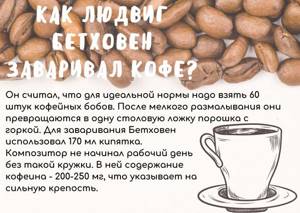
Counting spoons for making espresso
During brewing, some of the liquid evaporates. Each method of preparing the drink requires a different amount. To cook in a Turk, take 2 tbsp. l. finely ground grains and boil in 200 ml of boiling water. After brewing, pour into 30-50 ml portions. Makes 3-4 cups. Read more in the article “How many spoons of coffee to put in a Turk”.
Here are the options for ratios of measures for different brewing methods:
- For a French press, the norm is 200 ml of boiling water and 1 tbsp. l. medium grind powder with a full heap. The same standards apply to coffee pots.
- Place 2 tsp into a drip device with a filter. and pour 120 ml of water.
- For a geyser unit per 100 ml you need to put 1 tbsp. l. beans ground to medium.
The brewed product is poured into 30-35 ml. In an automatic coffee machine with capsules or pods, you do not need to count how many grams of coffee or spoons.
Interesting! How to grow Arabic coffee in a room - characteristics of the plant, and methods
Coffee preparation methods
It is difficult for an ordinary connoisseur of an aromatic drink to compare with the skill of experienced baristas in making coffee, but nothing is impossible. You can also brew excellent coffee at home - black, strong, with a pronounced taste. Most often, several old and proven methods are used for this. The Coffee Brewing Calculator will help you calculate all the proportions of water and coffee for each brewing method.
Oriental coffee or Turkish coffee (cezve)
This is one of the oldest methods of brewing good coffee. A special vessel is used for it - a turk (cezve), it is a vessel widened at the bottom and narrowed at the neck, with a long side handle. Previously, they were made of copper alloy, tinned inside. The long handle allows you to safely hold the cezve over a fire or on a stove with hot sand. Modern cezves are made mainly from stainless steel, but there are also ceramic ones. An electric Turk would be a suitable option for an office.
Making Turkish coffee requires a lot more patience and skill. Finely ground coffee beans mixed with sugar are poured into the cezve. Then add cold water there in a ratio of 10:1 and heat it several times, not allowing it to boil. As soon as the foam starts to rise, remove the drink from the heat and wait until it cools a little, and then heat it again (the heating and cooling process should be repeated three times).
Never bring Turkish coffee to a boil!
Before pouring coffee into cups, it is worth adding a few drops of cold water to the container so that the coffee grounds fall to the bottom. To improve the taste, you can add a little cardamom or cinnamon.

Geyser coffee maker (MOKA)
For this method of brewing coffee, a special coffee maker is used, which was invented back in 1933 by the Italian Luigi De Pontii. It consists of two vessels in the form of truncated cones, in the middle between them there is a metal filter for ground coffee.
Preparation: fill the lower vessel with cold water, pour medium-fine coffee into a strainer. Place the coffee maker on the burner - boiling water in the lower reservoir, under the influence of the created pressure, passes through the coffee, and the finished drink is poured into a fountain into the upper reservoir.
Brewing coffee in Moka is not difficult and does not take much time, and the results obtained will please even coffee gourmets.
Coffee filter or drip method
The first drip coffee maker was invented more than 200 years ago by the French Archbishop Jeanne de Bellois, and an electric version appeared in the 50s of the last century. To prepare a coffee drink using this method, medium or medium-coarse ground coffee is used.
Water from the tank flows by gravity into the heater, and from there into a filter filled with coffee powder. The saturated liquid flows drop by drop from the filter into the lower container. The preparation time takes 4-6 minutes, the drink turns out soft, “Americano” type.
Do not use a very fine grind for the drip method, since with prolonged contact with water the level of extraction will be high and the drink may turn out to be very bitter.

French press
The piston method is one of the simplest and most accessible. The French Press is celebrating its centenary this year. This French invention consists of a tall glass cylinder and a piston on an axle attached to a lid.
Preparation method: pour coarsely ground coffee into the bottom of the vessel and add hot water. Let it brew for 3-5 minutes. After this time, the piston is smoothly lowered down, thus separating the grounds from the drink.
When brewing coffee in a French press, keep two things in mind:
- Before cooking, scald the cylinder with hot water, this will slow down the cooling and improve extraction;
- In a glass container, the drink cools quickly, so prepare it immediately before drinking.
Standard and doppio portions
In a coffee machine, calculations are included in the automation system. The unit itself measures boiling water in milliliters and the brewed product in grams. Typically, cups of 30-35 ml are obtained. Each contains two teaspoons of ground grains.
The concept of “double espresso” does not mean that the mass of crushed beans with a standard amount of liquid increases. The amount of both ingredients doubles.
The result is a product called “doppio”. 60 ml of brewed Robusta or Arabica is poured into prepared mugs. For cooking use 4 tsp. ground beans. For a triple portion of “triple”, take 6 spoons and plus 0.5-0.6 liters of water. A mug that can hold 90 ml is suitable for pouring.
How to brew a drink in Vienna
Special measuring containers with indicators in grams are sold for coffee machines. Experienced baristas keep all the numbers needed for their work in their heads.
Espresso is the basic basis for preparing various recipes.
To get Viennese coffee, you need to grind the beans and measure out 4 tsp. Pour 250 ml glass of boiling water. Cook in a pot and leave for 10 minutes. You will get increased strength.
But in the Viennese recipe it is necessary to add whipped hot (65-70 degrees) milk, which compensates for the excessive bitterness. You can determine how much coffee goes into one cup by dividing the total volume into parts of 40-50 ml. On average, you get a teaspoon of ground grain per serving.
Concentrated ristretto - miniature dishes
To prepare a ristretto, a coffee machine is required. For every 20 ml of water add 2 tsp. powder. The steam pressure is maintained at 9 bar during cooking. Water passes through the compressed mass of particles in 20-30 seconds.
Ristretto cups traditionally hold 18-20 ml. This is 2-3 sips of an invigorating drink with thick foam. One mini-mug contains a teaspoon of ground Arabica or Robusta. Glass cups without handles are often used.
Expert opinion
Vadim Kudryavtsev
Coffee expert, professional barista and simply in love with this aromatic drink.
Ask the barista a question
Sometimes ristretto is served in 60 ml mugs, filling a third or half of the volume. But an additional glass of water is always served to cleanse your mouth after each sip. Then the taste of the drink will always be the same as the original. This recipe can be used as a basis for preparing other types.
How much coffee per cup

When reading most coffee recipes, you will notice that the recommended amount of coffee is 7-9 grams per serving. Is this statement always true and how can it be translated into a more understandable language? Simply put, how much coffee per cup do you need to take to get a tasty drink?
In this matter, everything is not so simple, because there are quite a lot of types of coffee, as well as methods of preparing it. If you prepare espresso in a coffee machine, the recommended amount of coffee is 7 grams. Do not forget that the output is 30 ml of drink. For a serving of Turkish coffee, they take approximately 6 grams per 60 ml, i.e. To prepare 180 ml of drink, it is better to take about 20 g of coffee. But these are all just advisory figures; in fact, to prepare two servings of coffee at home, they take 12-15 grams.
How much coffee per cup should you add if you are preparing an invigorating drink in a French press or coffee pot? The answer will be the same for both methods: approximately 190 ml of water requires 10 g of ground coffee. Finally, a filter coffee maker will require 6-10 g of coffee for the same volume of water.

For more accurate measurements, it is better to have a measuring spoon for bulk products, otherwise the above information will be useless. If you don’t have such an item in your kitchen, in order to understand how much coffee you need to put in a cup, try to make do with ordinary cutlery and the following information:
– level teaspoon – 3-4 g of ground coffee; - heaped teaspoon - 6 g of coffee; - level tablespoon – 11-12 g of coffee; - heaped tablespoon - 17-18 g of coffee.

It turns out that to make coffee, for example, in Turkish coffee, you need to take one and a half to two heaped teaspoons. In reality, every coffee lover brews an invigorating drink at home the way he likes. The good thing about coffee is that love for it unites people even despite the language barrier, and at the same time it retains its versatility and diversity.
In automated coffee machines that operate on capsules and pods, the question “how much coffee to take per cup” does not arise. The required amount of ground coffee is already measured and packaged at the factory. As for instant coffee, it usually requires 2.5 grams per serving or 1 tsp. Please note that instant coffee is lighter than ground coffee, so it weighs less for the same volume.
In conclusion, it is worth saying that you should not forget about the maximum amount of coffee per day that you can drink without causing harm to your body. One liter of coffee contains up to 1500 mg of caffeine, and the daily dose of purine alkaloids, including caffeine, which is addictive, is 1000 mg. It turns out that in order to get caffeine addiction, it is enough to drink 2/3 liters of coffee a day for some time, and this is not that much. Drink coffee carefully and be healthy!
For Lungo and Americano
If the concentration is made at the rate of 2 tsp. finely ground to 70 ml of water, you get lungo. We recommend this recipe for lovers of bitterness. Passing more hot water through the ground Arabica coffee brings out the bittering components. Pour the drink into a container measuring 80-100 ml. The serving itself is 70 ml.
Interesting! About growing coffee at home
To prepare an Americano, you must first make the doppio. For each mug we take 60 ml of water and two teaspoons of ground beans. After brewing, add sugar and dilute with boiling water to taste. The volume of added liquid varies from 50 to 450 ml.
If diluted with cold water, you get a variety called “Iced Americano.”
How many teaspoons do you put in?
1 (one)2 (two)3 (three)4 (four)
How to make Turkish coffee?
The main question that interests everyone: “How much coffee should I add and how much water should I add?”
There is a traditional calculation: we take 1 teaspoon per 1 cup of water.
It is recommended to use the following proportion when preparing Turkish coffee: 2.5 g. coffee per 1 oz (ounce) ~ 30 ml.
180 ml (6 oz) 15 g. 2 cups 240 ml (8 oz) 20 g. 4 cups 300 ml (10 oz) 25g. 6 cups 420 ml (14 oz) 35 g. 10 cups 500 ml (17 oz) 42 g. 10 cups
| Turk volume | How many grams of coffee should I put in? | Calculation with teaspoons | How many cups do we cook for? |
| 50 ml (1.7 oz) | 4 g | 2 spoons | 1 cup |
| 100 ml (3.4 oz) | 8 g | 2 spoons | for 1-2 cups |
| 180 ml (6 oz) | 15 g | 4 spoons | 2 cups |
| 240 ml (8 oz) | 20 gr | 5 spoons | 4 cups |
| 300 ml (10 oz) | 25g | 5 heaped spoons | 6 cups |
| 500 ml (17 oz) | 42 g | 10 heaped spoons | 10 cups |
Popular in Eastern Europe and the Middle East, the turka, also known as cezva, briki, rakva, finjan and kanaka, is a vessel made of thin copper with a long handle. Coffee brewed in a Turkish coffee pot has a thick consistency. Ultra-fine grind, high temperature and the right water ratio create a full-flavored coffee.
What you will need:
- Freshly roasted coffee, the finest grind, “to dust.” You will get a fine grind in 15-18 seconds in a household coffee grinder.
- Flavored and single-origin coffee varieties are suitable for Turkish coffee.
Procedure:
- Pour cold water into the Turk and bring it to a boil at medium temperature.
- Remove it from the stove.
- Add coffee to the Turkish coffee - 1 teaspoon per cup - and add other ingredients as desired.
- Stir the contents of the Turk with a spoon.
- Place the Turk back on the stove and heat it, stirring gently, until foam appears. Do not allow it to boil under any circumstances!
- Remove from heat and let cool for 1 minute.
- Place back on the stove and heat again, stirring gently until foamy. Again, do not allow it to boil. Repeat one more time.
- Skim off any foam that has formed with a spoon and carefully pour the coffee into cups.
- Let the coffee sit for a couple of minutes and you are ready to drink.
For information:
- Repeat heating: optional. You can heat the coffee once, but repeating the heating several times will give the drink a thick texture.
- Pen. The long handle requires precision. When pouring coffee into a cup, do it slowly so as not to disturb the foam.
- Various recipes suggest adding sugar and spices to ground coffee.
Step-by-step instruction:
Another video:

How to make Turkish coffee?
Number of votes: 22 3
5
1
22
Was the information helpful? Rate and leave a comment? Better yet, share!
Comments
We will be glad if you share your opinion or add to a note or article.

